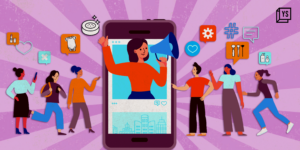Over the last few years, the global workforce has been continually evolving due to a number of factors. An increasingly competitive business landscape, rising complexity, and the digital revolution are reshaping the mix of employees.
The shift to a digital, knowledge-based economy shows that a vibrant workforce is more important than ever. Researchers suggest that skilled employees, exceptional leaders, and knowledge account for a significant portion of market capitalisation in public companies.
To any organisation, human capital is more important than ever and will be the primary factor in sustaining competitive advantage over time. The most important responsibility of the L&D team and organisation is to manage people’s development in a way that supports key business priorities.
COVID-19 hastened several changes that would have happened over the next decade. Remote working, hybrid work models became the norm overnight, requiring workplaces and employees to align accordingly.
The new modes of working also created new roles, a need for new skills across the board for all sectors. If this development had happened over the normal course of time, workers and companies would have had the chance to train people appropriately.
The rapid change, however, necessitates an equally rapid change in learning and development approaches. L&D teams have been more crucial, not just to impart knowledge but do it fast, and effectively. This requires a shift in the approach of L&D teams as well.
Changing Approaches
L&D teams have to adapt to new formats of training. Hybrid and remote work models require a digital approach to training. Additionally, decreasing attention spans needs the modules to be broken down into simpler programs. Bite-sized training programs are now the norm. These programs allow the employee to consume the material at their own pace, in quick, easy-to-understand modules.
The organisations are adapting along with their workforce to the quickly evolving world, shifting to new areas of demand. Even after the pandemic, there will be a substantial need for L&D to bring new workers up to speed rapidly and to diversify the skills of existing employees.
Another common trend is personalisation of learning modules. Every person has a different learning pace and comfort zone with different topics. Additionally, as learning modules are increasingly pushed online and implemented individually, L&D teams also need to focus on individual requirements – in terms of content and pace.
There have been many learning and development tools and technology to engage learners with ever more sophisticated digital experiences. But in the near future, the focus will move towards systems of productivity. It’s going to be a trend that will become increasingly central as teams across the organisation, including L&D, deal with budget freezes, cuts, and redundancies.
An L&D trend that has been made more important by the pandemic and is going to be a focal point is soft skills. To communicate and to support their teams, individuals should exhibit higher levels of soft skills than ever before.
Soft skills are often considered to be harder to learn but L&D teams can come up with great ways to improve leadership, problem-solving, communication, teamwork, adaptability and much more.
Interactive learning modules are also becoming increasingly common across industry. The healthcare industry, for example, uses a mix of Artificial Intelligence (AI) and Augmented Reality (AR) to train doctors on new technologies. This is crucial for the sector, where hands-on training is as important as theory and the room for mistakes is nil.
With the advancement of technology, more organisations across the nation are able to support remote working and experiential platforms, such as augmented reality (AR) and virtual reality (VR). These include more immediate and immersive experiences. L&D teams are using available data to create adaptive, customised, and realistic training programs with the use of AI, AR and VR for other sectors as well.
For any business’s success, growth and transformation, training and development will always be vital. Having a proper L&D strategy in place should be a key component of every organisation.
The organisation should also stay up to date with technology transformation and adoption to empower employees to succeed from the very start.
As a part of L&D, the organisation should encourage and provide the employees with opportunities to unite with colleagues through social learning or collaborations along with taking time to bring learning into the flow of work to make employee time more valuable. An active and continuous learning culture becomes very critical to every organisation and to its employees.
(Disclaimer: The views and opinions expressed in this article are those of the author and do not necessarily reflect the views of YourStory.)






![Read more about the article [Funding alert] Filo raises $23M in Series A round led by Anthos Capital](https://blog.digitalsevaa.com/wp-content/uploads/2022/01/VCfunding-1605087354569-300x150.jpg)



